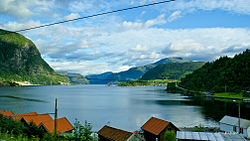world.wikisort.org - Norway
Erfjord is a former municipality in Rogaland county, Norway. The 132-square-kilometre (51 sq mi) municipality existed from 1914 until 1965. It encompassed the area around the Erfjorden in the southwestern part of the present-day municipality of Suldal. The administrative centre of the municipality was the village of Hålandsosen, where the Erfjord Church is located.[1]
Erfjord herred | |
|---|---|
Former municipality | |
 View of the fjord area | |
 Rogaland within Norway | |
 Erfjord within Rogaland | |
| Coordinates: 59°21′N 06°13′E | |
| Country | Norway |
| County | Rogaland |
| District | Ryfylke |
| Established | 1 Jan 1914 |
| • Preceded by | Jelsa Municipality |
| Disestablished | 1 Jan 1965 |
| • Succeeded by | Suldal Municipality |
| Administrative centre | Hålandsosen |
| Area (upon dissolution) | |
| • Total | 132 km2 (51 sq mi) |
| Population (1965) | |
| • Total | 610 |
| • Density | 4.6/km2 (12/sq mi) |
| Time zone | UTC+01:00 (CET) |
| • Summer (DST) | UTC+02:00 (CEST) |
| ISO 3166 code | NO-1137 |
History
The municipality of Erfjord was created on 1 January 1914, when the municipality of Jelsa was split in two: the western part remained as Jelsa, and the eastern part became Erfjord. Initially, Erfjord had 617 inhabitants. On 1 January 1965, a major municipal consolidation took place due to the recommendations of the Schei Committee. Erfjord municipality ceased to exist and it was merged with the municipalities of Sand and Suldal as well as part of the municipalities of Jelsa and Imsland to form the new (much larger) municipality of Suldal. At the time of its dissolution, Erfjord had 610 residents.[2]
Government
All municipalities in Norway, including Erfjord, are responsible for primary education (through 10th grade), outpatient health services, senior citizen services, unemployment and other social services, zoning, economic development, and municipal roads. The municipality is governed by a municipal council of elected representatives, which in turn elects a mayor.[3]
Municipal council
The municipal council (Herredsstyre) of Erfjord was made up of representatives that were elected to four year terms. The party breakdown of the final municipal council was as follows:
| Party Name (in Norwegian) | Number of representatives | |
|---|---|---|
| Local List(s) (Lokale lister) | 13 | |
| Total number of members: | 13 | |
| Party Name (in Norwegian) | Number of representatives | |
|---|---|---|
| Local List(s) (Lokale lister) | 13 | |
| Total number of members: | 13 | |
| Party Name (in Norwegian) | Number of representatives | |
|---|---|---|
| Local List(s) (Lokale lister) | 13 | |
| Total number of members: | 13 | |
| Party Name (in Norwegian) | Number of representatives | |
|---|---|---|
| Local List(s) (Lokale lister) | 12 | |
| Total number of members: | 12 | |
| Party Name (in Norwegian) | Number of representatives | |
|---|---|---|
| Local List(s) (Lokale lister) | 12 | |
| Total number of members: | 12 | |
| Party Name (in Norwegian) | Number of representatives | |
|---|---|---|
| List of workers, fishermen, and small farmholders (Arbeidere, fiskere, småbrukere liste) | 7 | |
| Local List(s) (Lokale lister) | 5 | |
| Total number of members: | 12 | |
| Party Name (in Norwegian) | Number of representatives | |
|---|---|---|
| Local List(s) (Lokale lister) | 12 | |
| Total number of members: | 12 | |
| Note: Due to the German occupation of Norway during World War II, no elections were held for new municipal councils until after the war ended in 1945. | ||
See also
- List of former municipalities of Norway
References
- Store norske leksikon. "Erfjord – tidligere kommune" (in Norwegian). Retrieved 19 May 2015.
- Jukvam, Dag (1999). "Historisk oversikt over endringer i kommune- og fylkesinndelingen" (PDF) (in Norwegian). Statistisk sentralbyrå.
- Hansen, Tore, ed. (12 May 2016). "kommunestyre". Store norske leksikon (in Norwegian). Kunnskapsforlaget. Retrieved 13 July 2020.
- "Kommunevalgene 1963" (PDF) (in Norwegian). Oslo: Statistisk sentralbyrå. 1964. Retrieved 14 July 2020.
- "Kommunevalgene og Ordførervalgene 1959" (PDF) (in Norwegian). Oslo: Statistisk sentralbyrå. 1960. Retrieved 14 July 2020.
- "Kommunevalgene og Ordførervalgene 1955" (PDF) (in Norwegian). Oslo: Statistisk sentralbyrå. 1957. Retrieved 14 July 2020.
- "Kommunevalgene og Ordførervalgene 1951" (PDF) (in Norwegian). Oslo: Statistisk sentralbyrå. 1952. Retrieved 14 July 2020.
- "Kommunevalgene og Ordførervalgene 1947" (PDF) (in Norwegian). Oslo: Statistisk sentralbyrå. 1948. Retrieved 14 July 2020.
- "Kommunevalgene og Ordførervalgene 1945" (PDF) (in Norwegian). Oslo: Statistisk sentralbyrå. 1947. Retrieved 14 July 2020.
- "Kommunevalgene og Ordførervalgene 1937" (PDF) (in Norwegian). Oslo: Statistisk sentralbyrå. 1938. Retrieved 14 July 2020.
Другой контент может иметь иную лицензию. Перед использованием материалов сайта WikiSort.org внимательно изучите правила лицензирования конкретных элементов наполнения сайта.
WikiSort.org - проект по пересортировке и дополнению контента Википедии

